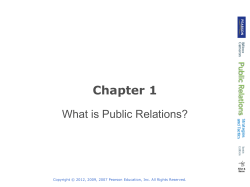
Developing Oral and Online Presentations Copyright © 2010 Pearson Education International
Developing Oral and Online Presentations Copyright © 2010 Pearson Education International Chapter 16 - 1 Learning Objectives • Explain how oral and online presentations can influence your career and learn to adapt the three-step process to oral presentations • Explain why limiting your scope is especially important for oral presentations • Discuss the three functions of an effective introduction Copyright © 2010 Pearson Education International Chapter 16 - 2 Learning Objectives • Identify six ways to get and hold your audience’s attention • Describe the techniques you can use to feel more confident in front of an audience • List six steps you can take to handle questions during a presentation Copyright © 2010 Pearson Education International Chapter 16 - 3 Building Your Career with Oral Presentations • Display your skills • Think on your feet • Grasp complex issues • Handle challenges Copyright © 2010 Pearson Education International Chapter 16 - 4 The Three-Step Process • Planning • Writing • Closing Copyright © 2010 Pearson Education International Chapter 16 - 5 Planning the Presentation • Analyze the situation • Gather the information • Select the medium • Organize the message Copyright © 2010 Pearson Education International Chapter 16 - 6 Analyzing the Situation • Information • Persuasion • Collaboration Copyright © 2010 Pearson Education International Chapter 16 - 7 Analyzing the Audience • Supportive • Interested but neutral • Uninterested • Apprehensive • Hostile Copyright © 2010 Pearson Education International Chapter 16 - 8 Assessing the Environment • Seating arrangements – Classroom or theater – Conference table – Horseshoe or “U” shape – Café style Copyright © 2010 Pearson Education International Chapter 16 - 9 Selecting the Medium • In-person presentations • Web-based presentations Copyright © 2010 Pearson Education International Chapter 16 - 10 Organizing the Presentation • Define the main idea • Limit the scope • Choose the approach Copyright © 2010 Pearson Education International Chapter 16 - 11 Preparing the Outline I. State purpose and main idea II. Group major points and subpoints III. List introduction, body, and close IV. Show your connections V. Show your sources VI. Choose a title Copyright © 2010 Pearson Education International Chapter 16 - 12 The Speaking Outline • Follow the planning outline • Condense points and transitions to keywords • Add delivery cues • Arrange your notes Copyright © 2010 Pearson Education International Chapter 16 - 13 Writing the Presentation • Adapting to the audience • Composing the presentation Copyright © 2010 Pearson Education International Chapter 16 - 14 Adapting to the Audience • Small groups – Casual style, promote participation, use simple visuals • Large audiences – Formal style, control participation, use multimedia Copyright © 2010 Pearson Education International Chapter 16 - 15 Composing the Presentation • The introduction – Arouse interest – Build credibility – Preview message Copyright © 2010 Pearson Education International Chapter 16 - 16 Composing the Presentation • The body – Discuss ideas – Connect ideas – Capture attention Copyright © 2010 Pearson Education International Chapter 16 - 17 Composing the Presentation • The conclusion – Restate main points – Describe next steps – End on a strong note Copyright © 2010 Pearson Education International Chapter 16 - 18 Completing Presentations • Master the delivery • Prepare to speak • Overcome anxiety • Respond to questions Copyright © 2010 Pearson Education International Chapter 16 - 19 Mastering Your Delivery • Memorizing • Reading • Impromptu speaking • Speaking from notes Copyright © 2010 Pearson Education International Chapter 16 - 20 Preparing to Speak • Check the location • Consider your audience • Adapt to other cultures Copyright © 2010 Pearson Education International Chapter 16 - 21 Overcoming Anxiety • Practice, practice, practice • Prepare more material than necessary • Think positively • Visualize your success • Take a few deep breaths • Be ready Copyright © 2010 Pearson Education International Chapter 16 - 22 Overcoming Anxiety • Don’t panic • Be comfortable • Concentrate on your message • Focus on your audience • Maintain eye contact • Keep going Copyright © 2010 Pearson Education International Chapter 16 - 23 Speaking with Confidence • Nonverbal signals – Controlled beginning – Relaxed posture – Sound of your voice Copyright © 2010 Pearson Education International Chapter 16 - 24 Responding to Questions • Focus on the questioner • Respond appropriately • Maintain control • Survive the hot seat • Encourage questions • End the presentation Copyright © 2010 Pearson Education International Chapter 16 - 25
© Copyright 2025





















